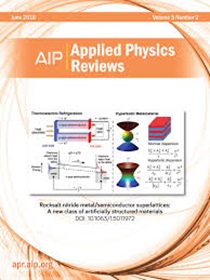为什么改善 n 型 Bi2Te3 合金的热电特性具有挑战性?
IF 11.9
1区 物理与天体物理
Q1 PHYSICS, APPLIED
引用次数: 0
摘要
尽管在 n 型 Bi2Te3 合金的 p 型材料方面取得了重大进展,但成功应用纳米技术增强其热电特性仍然是一项艰巨的挑战。n 型材料固有的独特挑战包括缺陷结构与电子浓度之间的复杂关系,以及热电特性的强烈各向异性。电子来自各种缺陷结构,如杂质掺杂物、空位、反位元缺陷和晶粒/晶域边界,其敏感性随材料合成工艺的不同而变化。此外,热电特性明显的各向异性要求晶粒沿着特定的晶体学方向排列。因此,实现高性能 n 型 Bi2Te3 合金的挑战在于难以独立控制缺陷结构(电子浓度)、纹理微结构(电子/声子传输特性)和纳米特性。本综述旨在全面了解与这些方面相关的困难和挑战,并探讨实现高性能 n 型 Bi2Te3 合金的潜在途径。本文章由计算机程序翻译,如有差异,请以英文原文为准。
Why is it challenging to improve the thermoelectric properties of n-type Bi2Te3 alloys?
The successful application of nanotechnologies in enhancing thermoelectric properties of n-type Bi2Te3 alloys remains a formidable challenge, despite significant advancements in their p-type counterparts. The distinctive challenges inherent to n-type materials include the complex relationships between defect structures and electron concentration, and the strong anisotropy of thermoelectric properties. Electrons originate from various defect structures, such as impurity dopants, vacancies, antisite defects, and grain/domain boundaries, which sensitively varies depending on material synthesis processes. Moreover, the pronounced anisotropic nature of thermoelectric properties requires grain alignment along specific crystallographic directions. Therefore, the challenges in achieving high-performance n-type Bi2Te3 alloys lie in the difficulties of independently controlling defect structures (electron concentration), textured microstructures (electron/phonon transport property), and nanofeatures. This review aims to provide a comprehensive understanding of the difficulties and challenges associated with these aspects, and to discuss potential routes for realizing high-performance n-type Bi2Te3 alloys.
求助全文
通过发布文献求助,成功后即可免费获取论文全文。
去求助
来源期刊

Applied physics reviews
PHYSICS, APPLIED-
CiteScore
22.50
自引率
2.00%
发文量
113
审稿时长
2 months
期刊介绍:
Applied Physics Reviews (APR) is a journal featuring articles on critical topics in experimental or theoretical research in applied physics and applications of physics to other scientific and engineering branches. The publication includes two main types of articles:
Original Research: These articles report on high-quality, novel research studies that are of significant interest to the applied physics community.
Reviews: Review articles in APR can either be authoritative and comprehensive assessments of established areas of applied physics or short, timely reviews of recent advances in established fields or emerging areas of applied physics.
 求助内容:
求助内容: 应助结果提醒方式:
应助结果提醒方式:


